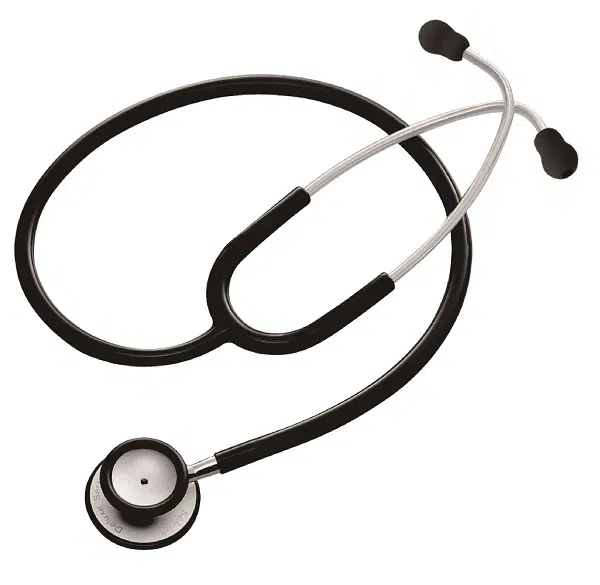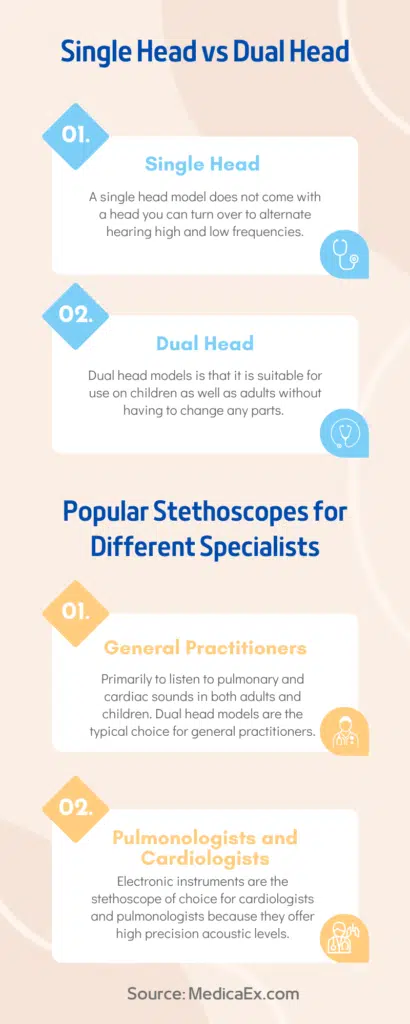Table of Contents
Stethoscopes, which have been around for some 200 years, are acoustic, medical instruments used primarily for medical and veterinary diagnosis.
With a stethoscope, sounds from inside the patient’s body may be heard, mainly those related to respiratory and cardiac activities.
There are two main categories of medical stethoscopes: electrical and mechanical.
Electrical Stethoscopes
These are the prevalent choice for cardiologists and pulmonologists because they excel at amplifying sounds picked up without distortion and are also able to reduce any external sounds.
Offering high precision as well as top listening quality, an electrical stethoscope will display the heart rate of the patient on the LCD screen.
Some models come with a Bluetooth connection so lung and heart sounds can be sent directly to a computer and be recorded, viewed, stored, or shared with a colleague. Some electrical models include an idle listening mode so they can automatically shut off and save power.
Electrical stethoscopes are popular with specialists wishing to carry out their diagnoses with high precision or analyze the results.
Mechanical Stethoscopes
The mechanical stethoscope is the world’s first bedside diagnostic tool and is still used as much today as ever. There are models designed for use on adults and also those designed for use on children. In addition there are mechanical stethoscopes which are equally precise for both adults and children.
Some of these instruments have interchangeable heads so you can switch from adult patients to children or vice versa.
Named after their creator, Pinard stethoscopes are made from aluminum or wood. They are designed for obstetrical use, allowing the practitioner to listen to a fetal heartbeat from the mother’s womb. This is a specific type of stethoscope and has an elongated cone connected to a perforated cylindrical plate. This design amplifies the fetus’s heartbeat which can be trickier to hear if the patient has a large stature.
Mechanical stethoscopes designed for cardiology have high acoustic sensitivity. This enables the doctor to identify various pulmonary or cardiac pathologies. Some of these are suitable for use on any age patient while others are designed for either adults or children. These models are a powerful and effective diagnostic tool.
The Three Parts of a Stethoscope
The chest piece, tubing and head are the three parts of a traditional stethoscope. Not every stethoscope has all these parts however. The Pinard, for example, does not have tubing or a chest piece.
The head is the part of the instrument that will make contact with the patient’s skin and pick up any sounds. The head is made up of the diaphragm, the bell and the base. The diaphragm is the flat part of the stethoscope which lets you listen to mid- and high-frequency sounds.
The rounded part, known as the bell, picks up low frequency sounds. A stethoscope with a bell and diaphragm are called ‘dual-head’ since you can flip the head over depending on the frequency you want to hear. The part that links the tubing to the head is called the base.
The tubing is a tube connecting the chest piece to the head and carries the sounds. Some instruments have double tubing which enables sound to travel more easily and sound clearer in the doctor’s ears.
A stethoscope’s chest piece is the metal part where the tubing connects, and comprises two ear tubes, two eartips and a tension spring. The ear tubes, also known as aural tubes, can be adjusted to make their angle suit the user’s anatomy. The eartips can be rigid or flexible. They are tricky to remove and are clipped on to the branches. Some models come with an extra set of hard eartips and soft eartips.
Essential Elements to Consider When Purchasing for a Stethoscope
Since there are different types of stethoscopes, it is important to take various criteria into account before making your decision, so you can ensure it is the best fit for your needs. Here are some additional factors to keep in mind:
Single Head vs Dual Head
A single head model does not come with a head you can turn over to alternate hearing high and low frequencies, although if a double frequency diaphragm is equipped on the instrument, you can apply gentle pressure to hear low frequencies and a little more pressure to hear those of a higher frequency.
Single head stethoscopes limits sound loss and propagates sound perfectly. The shape of a single head stethoscope makes it a good choice for measuring blood pressure since it slides under the cuff easily.
A dual head model, on the other hand, is suitable for listening to different kinds of sounds. It is not limited to lung and heart sounds, but can also be used for abdominal sounds and those from carotid arteries.

Put the bell of the stethoscope on the skin on top of the carotid artery and you can listen to sounds which characterize stenosis. The bell can be used on the median area of the abdomen to hear a systolic heart murmur which could indicate aortic aneurysm.
Another benefit of dual head models is that it is suitable for use on children as well as adults without having to change any parts. Use the larger surface for adults and patients of a larger stature or the smaller one for pediatric patients or underweight adults. Some types have a double frequency diaphragm on both the small and large heads to optimize listening in adult and child patients.
Types of Tubing
The tubing can be latex, rubber, PVC, or another material. Some is latex-free and/or natural resin-free to avoid allergies in the patient and doctor. Some tubing has rigid eartips while others come with soft ones. Soft ones are typically more comfortable and offer improved durability and sound insulation. Both types come in both large and small sizes.
An anti-chill ring is featured on some stethoscopes and this prevents patients from having their skin in direct contact with the cold metal. This is especially handy for child patients.
Another option is single or double tubing. With double tubing you can listen in stereo which is more accurate and there is no volume loss like with single tubing.
Popular Stethoscopes for Different Specialists
Every practitioner will want the stethoscope best suited to their requirements, depending on which diseases they treat and their area of expertise.
General practitioners, pulmonologists and cardiologists, physiotherapists, nurses, pediatricians, and veterinarians each have their own needs when it comes to which type of stethoscope is more useful. We can look at each of these medical specialties in turn.
General Practitioners
Stethoscopes are used every day by these doctors, primarily to listen to pulmonary and cardiac sounds in both adults and children. Dual head models are the typical choice for general practitioners, since they can use the same instrument to example children and adults, simply by flipping the head.
Pulmonologists and Cardiologists
Electronic instruments are the stethoscope of choice for these specialists because they display cardiac or pulmonary functions on the LCD screen and offer high precision acoustic levels.
Although electronic stethoscopes cost more than mechanical ones, the practitioner will be able to hear both low and high frequencies to diagnose cardiac or pulmonary pathologies with such a device. In addition, electronic stethoscopes allow the doctor to amplify the volume of a sound up to 20 times louder than with mechanical ones.

Physiotherapists
These medical professionals use stethoscopes before and after a physiotherapy session to listen to the lungs. Since their main function is pulmonary, most physiotherapists opt for a single head model.
Nurses and Nursing Students
Measuring blood pressure is the main function of a nurse’s stethoscope and most will use a single head mechanical version which easily slips under the cuff.
Pediatricians
These specialists treat children only, so will choose a small headed model of stethoscope. Some of these instruments come in bright colors or have adjustable animal figures to reassure these young patients during auscultation. Most pediatricians prefer a single head stethoscope fitted with an anti-chill ring.
Veterinarians
A veterinarian will use a mechanical stethoscope which is suitable for use on specific kinds of animals.
In Conclusion
As you can see, stethoscopes come in a variety of shapes and sizes, and have different features. The best stethoscope to choose depends on what you plan to use it for as well as your personal preferences and budget.
As well as buying a stethoscope, it is a good idea to also purchase the carrying case too, so you can keep the instrument protected and clean when not in use.
Share infographics










